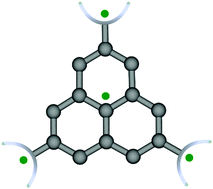Electronic structure and magnetic properties of the triangular nanographenes with radical substituents: a DFT study†
Abstract
A series of neutral triangular polycyclic aromatic hydrocarbons functionalized with various radical groups (dithiadiazolyl, verdazyl, nitronylnitroxyl, tert-butyl-nitroxyl and also (2,2,6,6-tetramethylpiperidin-1-yl)oxyl) has been computationally studied by the DFT UB3LYP/6-311++G(d,p) quantum-chemical modelling of their electronic structure and magnetic properties. The dependence of the nature and strength of the exchange interactions between paramagnetic centers on the size of the triangular core, the presence of heteroatoms in the polycyclic moiety, the type of the radical substituents and their spatial arrangement has been ascertained. The molecules with the high-spin electronic ground state possessing strong ferromagnetic exchange interactions and virtually non-interacting paramagnetic centers have been revealed, which makes them promising building blocks for organic spintronics devices.



 Please wait while we load your content...
Please wait while we load your content...